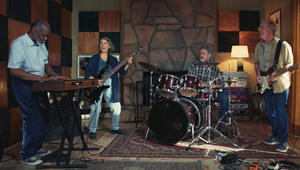
How Can You Be Fearless?

David&Goliath’s strategy and social impact director, Madison Cameron was born in Oregon and grew up with a passion for making a difference. As a kid, this often manifested in presentations convincing her parents why they needed to rescue yet another dog. However, today, it looks like fighting injustices such as teen cyberbullying (‘I Am A Witness’), over-medicating children (‘Outride ADHD’), police brutality through the ‘Not A Gun’ and ‘Not A Crime’ campaigns and more. Driven by helping brands to develop their purpose and corporate citizenship, she has worked with brands such as BMW, Disney, Comcast and more, and presently spearheads David&Goliath’s social impact strategy across its current clients and new business.
A decade ago, Madison made the decision to give up ‘fear’ for Lent. An unconventional Lenten sacrifice, the strategist has since used this mindset to push beyond her comfort zone and rethink how she approaches scary situations. On the 10th anniversary of this life-altering change, she tells LBB how, after years of letting fear hold her back, she finally decided it was time to embrace the emotion and find value in its presence.
10 years ago, I gave up fear for Lent.
I grew up incredibly cautious and even fearful of things that, in hindsight, I really didn’t need to be scared of. Everything from boats (regardless of the size) to aeroplane bathrooms (this one still gets me) to sitting in traffic sent my claustrophobia through the roof. But in 2013, I decided no more.
I realised ‘fear’ was the thing holding me back from the life that I could live and I gave up fear for Lent. In part, because I really didn’t want to give up chocolate again - but I digress.
So, what does ‘giving up fear’ mean? It meant that any time I was scared to do something - any time I had that pit in my stomach telling me that I should be afraid - I made myself do that thing. Getting outside of my comfort zone was a muscle I’d hardly ever flexed, and it was incredibly weak when I started out. Whenever someone would suggest an activity or an idea that stirred up feelings of fear, I made myself move towards it. It was everything from writing my name and number down on a receipt to rafting waterfalls to abseiling into caves to skydiving to scuba diving to volunteering for new opportunities that scared me.
With time, that muscle grew stronger and I grew increasingly comfortable with fear entering my personal space. With time, fear became excitement. With time, I went from letting fear come to me to actively seeking it out - from defence to offence.
As it turns out, it was never about giving up fear - far from it. The reality is, giving up fear or living a life without being afraid is unrealistic. Fear is one of the seven universal emotions experienced by everyone around the world. It keeps us safe when there’s real danger and, most importantly, triggers the opportunity to be brave.
As Glennon Doyle says, “If you can’t beat the fear, just do it scared.” Even the most adventurous, daredevil athletes experience immense amounts of fear - experiencing that fear and doing it anyway is what makes them brave. Professional skier Angel Collinson works through fear by “offering it a seat at the table.” Having the mental fortitude that comes with getting comfortable with fear - with welcoming it into your personal space because you see the value in it - is to live bravely.
With time, one can go from letting fear hold them back to becoming comfortable with that fear in their personal space to actually seeking the fear out - to putting fear on the defence instead. When we can understand that fear is a good thing and that seeking it out allows us to have control over that fear, our comfort zones are able to rapidly expand.
Now, that all might sound cool or interesting in theory (hopefully it does), but what do you do when you actually feel fear in the moment? I’d like to share five tools that have helped me:
1. Slow your heart rate down. Take a deep breath and actively think about slowing your heart rate. You cannot think clearly or move forward if your heart is racing (this trick also works if you can’t find your keys).
2. Offer fear a seat at the table. Remember, fear isn’t a bad thing. Let it in.
3. Ignite your inner superhero with this two-minute power pose.
4. Find and utilise your ‘I’m a fucking badass’ jam. I’ve linked mine here if you need any inspiration.
5. Remember that you have a 100% success rate at surviving hard things. As a strategist, looking at the data always helps me. You’ve got this.
You can utilise these tools before skydiving, but you can also utilise them before a pitch or a creative review. You can tap them before a hard conversation with a family member or when faced with a challenging decision. As a brand, you can choose to seek out the challenges and ‘Goliaths’ that are holding you back from making true cultural, social, and business impact or from changing the status quo. The more you find moments in your life to welcome fear in and just do things scared, the stronger that ‘brave muscle’ will become.
So, while yes, fear is something that can hold us back, it’s not something to give up. It’s something to embrace wholeheartedly - it’s something to offer a seat at the table.















